Repurposing content is one of those strategies that every content marketer knows they should be doing. The idea of recycling content to reach a wider audience is a great opportunity.
Many of us are so focused on churning out piece after piece, that we completely forget about all the great content we’ve already produced.
If you’ve been creating content for a while, you likely have tons of useful articles on your blog, YouTube Channel, or as downloadable assets that could be reused in other ways. In this article, you’ll learn how you can take your available content and reuse it to save time, reach a new audience, and squeeze the most value out of your current resources.
Why should you repurpose content?
It saves time
Creating quality content takes a lot of time. You may need to conduct keyword research, brainstorm article ideas, write a video script, gather expert quotes, the list of tasks goes on and on. Putting together a valuable resource can take up a significant portion of your week.
For most of us, this cycle repeats and repeats, always focusing on the next piece of content. The time it takes to publish new resources adds up. By repurposing content, however, you can draw from past articles, videos, or other assets and cut down on time it takes to produce new assets.
You can reach a new audience
Some people like to consume content by reading articles or blog posts, others prefer to watch videos, while some like audio-only content (e.g., podcasts and audiobooks).
If you only publish written content, you could be missing an entire group of potential customers. By reformatting content, though, you can reach each of different groups of people.
Not every type of content will make sense for your target audience. This is why it’s important to create buyer personas so you can outline the types of content your customers enjoy.
It allows you to get the most out of your content
Lastly, you’ll ensure that you receive the most return on investment when it comes to each content piece.
How to choose what content to repurpose
There are a number of places you can find content to repurpose, and it doesn’t always have to be your own. Turning a Quora question into a separate blog post is a good example.
However, when looking at your own content, there two things to look for when deciding whether a specific piece is worth repurposing:
Find your evergreen content
Evergreen content is always relevant, regardless of how much time goes by. It’s usually on a topic that will continually be searched and receive a genuine interest from your audience. It does not include fad topics or time-based information (like a Google algorithm change from 2012).
When deciding which of your content to repurpose, you should use only your evergreen content. This way, you know that your efforts will pay dividends for years to come.
Use your most popular content
Another way to find content that is worth repurposing is by looking at your most popular content.
- What has resonated with your audience the most?
- Which piece was shared the most on Facebook or Twitter?
- Which piece receives the most monthly traffic?
- Which of your videos has received the most views on YouTube?
Narrow down your top performing blog posts and videos by traffic, shares, and even comments (this will tell you how this piece has been perceived by your audience). Any piece with a high number in any of these areas is a good place to start.
How to repurpose your content (examples)
1. Turn a blog post into an ebook/guide or vice versa
The first idea on this list is to turn a blog post, or list of posts, into an ebook or downloadable guide. For example, say you wrote an article on each of the following topics:
- What is SEO?
- How does SEO work?
- SEO best practices
- How to build backlinks
- White-hat SEO techniques
Each of these topics are a subtopic of SEO. You could combine each of these topics into one in-depth ebook that you can then promote across your blog.
The team at Zapier has used this technique by creating one in-depth ebook every 90 days:
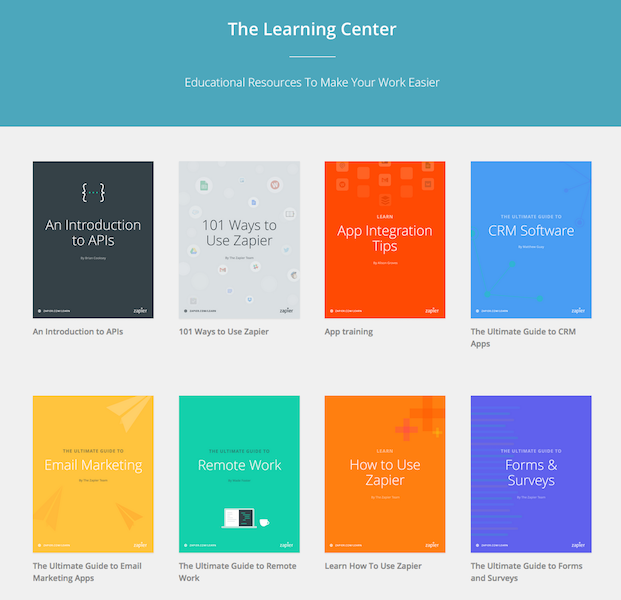
The results? Over 15,000 downloads and an increase of 10,000 email subscribers.
The opposite also works great, turning an ebook into a list of blog posts. If you published a lengthy ebook, you could break that ebook down into separate articles.
For a step-by-step approach to turning your blog posts into an ebook or vice versa, check out the following resources:
- “Maximize Your Marketing: How to Easily Turn Blog Posts Into an Ebook” by HubSpot
- “How to Turn Ebooks into Blog Posts that Drive Traffic for Your Website” by SmartBug
2. Create a round-up post
An insanely simple way to repurpose your content is to create a round-up post. All you do is gather a group of your most popular articles and link them in your new round-up post. Then, you can share the post to your email list and social media.
For example, this round-up post by Design Milk that links to their best articles in 2017:

3. Turn a blog article into an infographic
If you have a blog post or report with content that could be shown visually (like statistics), creating an infographic is another way to reformat that content.
As an example, Blogging Wizard took their blog article titled, “The Blogger’s Guide To Understanding The Psychology Of Social Networks” and turned the statistics from that post into an infographic published to their blog.
You don’t need to hire a graphic designer to create one either. Tools like Canva, Piktochart, and Venngage all have drag-and-drop builders and templates that enable you to design an infographic on your own.
4. Turn a blog article or web page into a short video
Again, if you have a lengthy post or a resource page (like a glossary), you can break sections of that page down into short videos to then publish on YouTube.
For instance, we took the content from this long-form resource page and condensed it into a short 2-minute video titled, “What is a post-click landing page:”
5. Convert a blog into a content upgrade
Content upgrades are a bonus piece of gated content that a visitor can sign up for in exchange for their email. It’s a popular list building method and works much like other lead magnets such as ebooks and white paper downloads.
However, content upgrades are typically shorter and crafted for a specific blog post. Ideas include:
- PDF version of a blog post
- Cheat sheet
- Checklist
- List of resources
- Template
For example, Brian Dean at Backlinko has a tutorial-style blog post titled, “How To Boost Conversions by 785% in One Day (The Content Upgrade)”. In that post, he includes a checklist content upgrade that sums up steps mentioned in the post.
You can use the same technique on your blog if you have a lengthy tutorial or a long list of resources.
6. Repurpose a blog into multiple guest posts
Guest posting is a popular content marketing method to build backlinks, increase brand exposure, and put yourself in front of a new audience.
However, rather than coming up with a completely new topic for your guest post, why not draw ideas and repurpose content from an existing article on your blog?
Say you have a blog post titled, “The Complete Guide to Creating a Content Strategy.” That post would likely include sections on deciding what type of content to create, conducting a content audit, defining key performance indicators (KPIs), creating a content calendar, and promotion.
Each of those sections could be developed into a full-length blog post that you pitch as a guest post. This would be a great way to secure a backlink to your original article.
The key is reformatting that content so that it’s original enough to be posted somewhere else. If one of the sections was titled, “How to Create a Content Calendar,” the guest post version could be a list post of tips, steps, or ideas for creating a content calendar.
If you’re unfamiliar with how to pitch guest posts successfully, these articles will help get you started:
- “Guest Blogging: The Definitive Guide (2018)” by Backlinko
- “Learn How to Write a Guest Blog or Use One on Your Site” by Lifewire
7. Turn a blog post into a new article on Medium
Medium has been a popular place to guest post and share content since its launch in 2012. For good reason too. The popular site has an established viewership of 60 million monthly readers.
Sometimes this content is entirely original, and other times it’s syndicated (meaning the post on Medium is identical to the original article on the author’s blog).
If you’re a website or blog that’s just starting out, posting on Medium can be a great way to reach an already established audience and increase exposure for your brand.
Benjamin Hardy, a freelance writer, author, and public speaker has been using Medium since 2015 to post repurposed articles from his own blog. From his Medium articles, he has added a call-to-action to opt-in and subscribe to his blog. Within six months, he grew his email list from 0 to 20,000 subscribers:
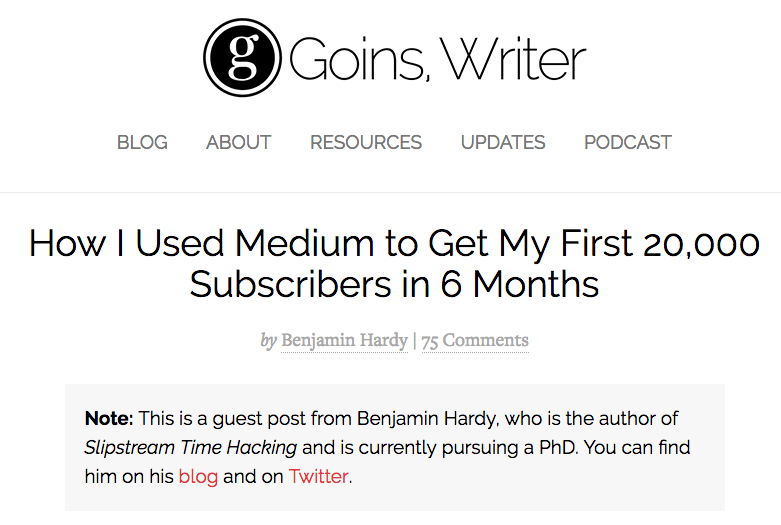
If you use Medium to publish an exact copy of your original blog post, make sure to:
- Wait a few days before publishing to Medium. If you publish to Medium directly after publishing the article on your own website, Google won’t have enough time to index your article first. Thus, Google might think the Medium version is the original post, and it could hurt your rankings.
- Link back to the original article.
8. Convert a blog post or ebook into an email series/course
Another idea is to turn your blog posts into an entire email series or course. This is a great way to collect email addresses from visitors to your site. Basically, you’d create a drip campaign that automatically delivers emails to these visitors over a set number of days after they signup with their email:
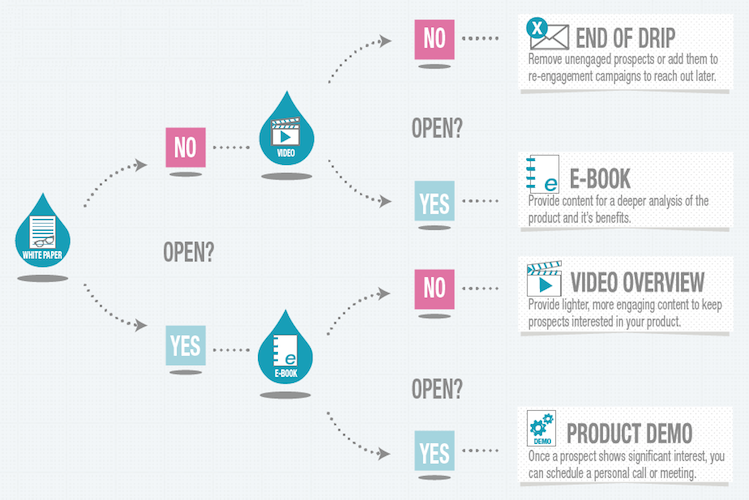
The first email might go out right away, the second after two days, and so on. This idea works well if you want to schedule product demos or meetings too since you can actively see who opened your email and create a custom drip campaign that sends signups different emails based on whether or not they opened your email.
There are a few ways to repurpose content using this method.
One, use the drip campaign to send signups to your blog posts. You might include a summary of the post in the email, but the end goal is to send them to the full article.
Two, create an exclusive series where all of the content is delivered in the email itself. If you take the earlier example blog post on content strategy, the first email could be titled, “What is a Content Strategy & Why Do You Need One?” The second could be titled, “3 Tips for Deciding What Type of Content to Create.”
If you don’t have a long-form piece of content like this on your blog to draw from, create a round-up from multiple posts. You can create an email with a round-up of helpful tips, facts, quotes from experts, or statistics.
Most of the top email platforms today will allow you to create multi-step drip campaigns. If you’ve never created a drip campaign before, this guide covers the basics as well as best practices.
9. Update past blog posts and repromote
This is a strategy that Buffer took to extreme limits. Back in 2015, Buffer decided to conduct a month-long experiment where they would only focus on updating past blog posts and promoting them. For a whole month, they did not create a single new article.
In that time, Buffer shifted their focus to repurposing two to three content pieces per week. The experiment saw organic search traffic grow by more than 4%.
10. Turn blog headers, statistics, and quotes into Twitter posts
Many companies share their latest blog post on social media with the title of the article. However, many times, that’s where the promotion stops. Rather than creating one social post, you can create a whole group of different posts from the headers, statistics, or even quotes used throughout that article.
For example, from their guide, “The Ultimate List of Marketing Statistics for 2018,” HubSpot could create a tweet for each of the different statistics presented:
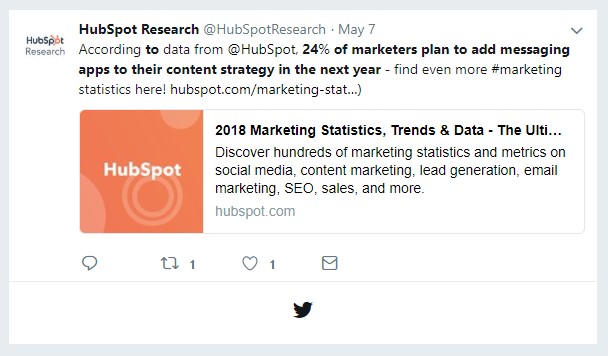
There are over 100 different statistics in that guide. Meaning, they could create over 100 different Twitter posts from this single page.
The same thing can be done with quotes from an expert round-up or even headers within a specific blog post.
Using a tool like Buffer, Hootsuite, or MeetEdgar can help you schedule social media posts over time.
11. Repurpose a Quora Q&A into a blog post
Repurposing content doesn’t always refer to the content on your own website. For instance, if you routinely answer questions on a site like Quora, you could turn your responses into a new blog post.
When asked the question, “How do I get an interview at Buffer?” on Quora, Leo Widrich (the Co-Founder & COO at Buffer) replied with an in-depth answer to the original poster:
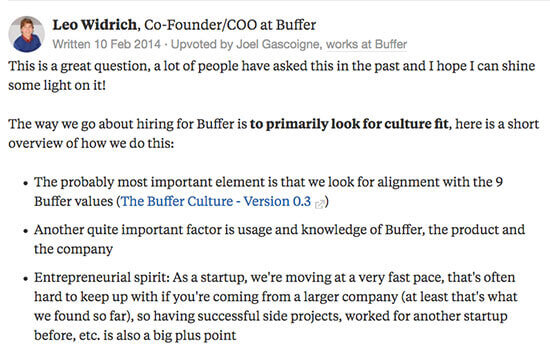
This post was then turned into a full-length article on Buffer.
12. Turn a webinar into a presentation or SlideShare
CopyBlogger used this exact method to turn their blog post titled, “The 3-Step Journey of a Remarkable Piece of Content” into a SlideShare that has received over 50,000+ views.
To create a SlideShare, you’ll first need to create a presentation using Powerpoint, Google Slides, Keynote, or another presentation builder. Then, go to SlideShare and upload it:
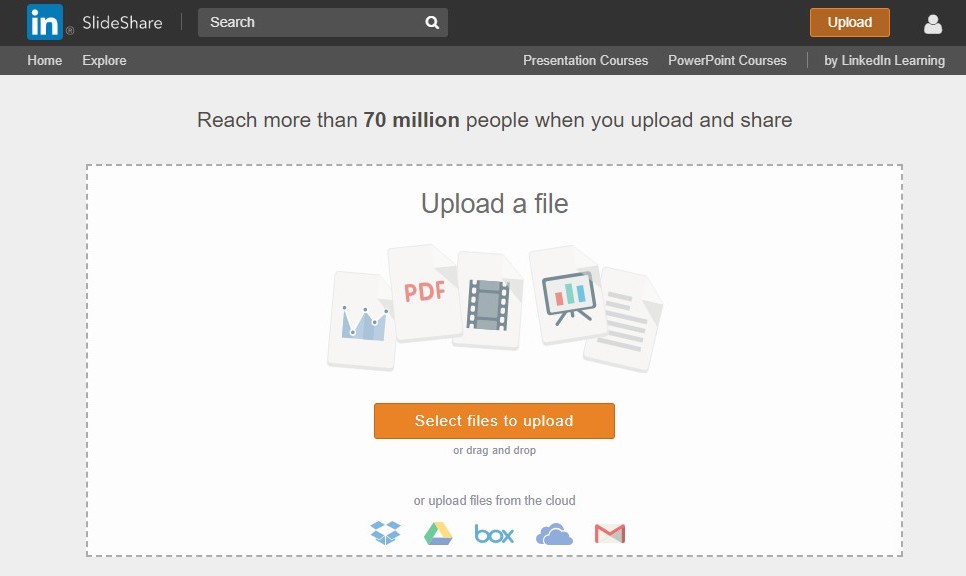
Once uploaded, SlideShare will turn it into a slide deck that visitors can find and view.
13. Turn a webinar into a YouTube video or blog post
Webinars are usually scheduled for a specific time that people can register for. They’re typically live events.
What if some of your website visitors can’t make the specific date the webinar is held?
Maybe they registered but missed the event or they neglected to sign up entirely because they knew it wouldn’t fit their schedule. Whatever the case, you can still make use of this content for those who couldn’t attend.
Since the webinar is a filmed event anyway, it should be easy to pull a few short videos from the webinar itself. Maybe there was a specific tactic mentioned that you could turn into a 5-minute video posted on YouTube?
Alternatively, you could screenshot some of the scenes from the webinar or use presentation slides to create a blog post.
Both ways allow you still make use of the webinar. Follow up with the people who couldn’t attend and let them know about the new content. This can also be a great way to promote your future webinars since these people will be able to get a sample of the information you provide.
Tools like Webinarjam and Demio will enable you to set up a webinar and record the session for future use:
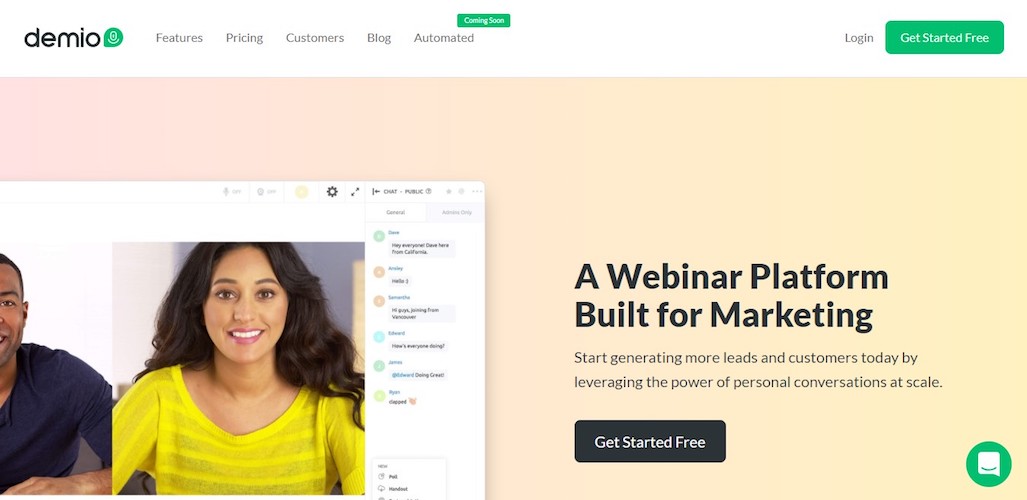
14. Create a Pinterest board from infographics
If your content is particularly visual, creating specific boards on Pinterest can be another way to repurpose content. For instance:
- A DIY website could create a board titled “How to Build a Coffee Table” and round up images from different coffee table projects featured on their website.
- A photography website could create a board with different photo shoot ideas that have been featured on their blog.
- A digital marketing company could combine all of the infographics they’ve created into a single board.
15. Write a blog article based on video content
Convince & Convert’s Jay Baer uses this method routinely.
Jay shoots and publishes a 3-minute video three times a week on topics including business, marketing, social media, and life. The best video from the previous week is then transcribed and reworked into three separate blog posts published to LinkedIn, Medium, and on the Convince & Convert blog:
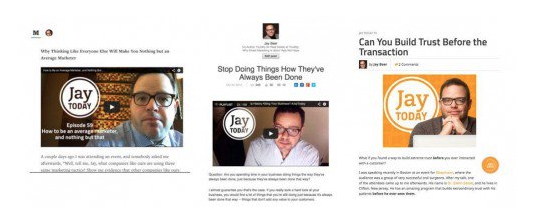
Moz, the popular SEO tool, also turns videos into full-length blog posts.
Every Friday, the Moz team films a short informative video as part of the company’s “Whiteboard Friday” series. In the videos, Moz breaks down topics related to SEO. In addition to publishing the videos, however, the content from the video is transcribed and reformatted into an entire blog post:

16. Turn a blog post into a podcast (or vice versa)
In a consumer report published by Edison Research and Triton Digital, the two companies found that 40% of respondents had listened to a podcast and 24% listen to podcasts on a monthly basis. Meaning, an estimated 112 million people in the U.S. have ever listened to a podcast while 67 million listen monthly.
That’s a huge number of people you could be missing out on by not creating podcasts. Creating one doesn’t have to be difficult, though. Turning a blog post into a podcast could be as simple as reading and recording it.
Jeremy Frandsen and Jason Van Orden used this exact tactic in their podcast, Internet Business Mastery. As part of an experiment, Jason and Jeremy decided to read and record their most popular blog posts. Then they uploaded the posts to their podcast. These “audio blogs” saw 60 to 100% more downloads than their featured podcasts.
Turn your content visitors into leads
With content repurposing the important thing to remember is that you don’t always need to publish new content. Through repurposing, you’ll save time, reach a wider audience, and get the most value out of every new piece of content you produce.
It’s not enough to focus on creating content and bringing in new visitors. Turning those visitors into leads and customers is what counts. To make the most of your content, download the ebook below. In it, you’ll learn proven ways to generate leads and turn your visitors into customers.

See the Instapage Enterprise Plan in Action.
Demo includes AdMap™, Personalization, AMP,
Global Blocks, heatmaps & more.
